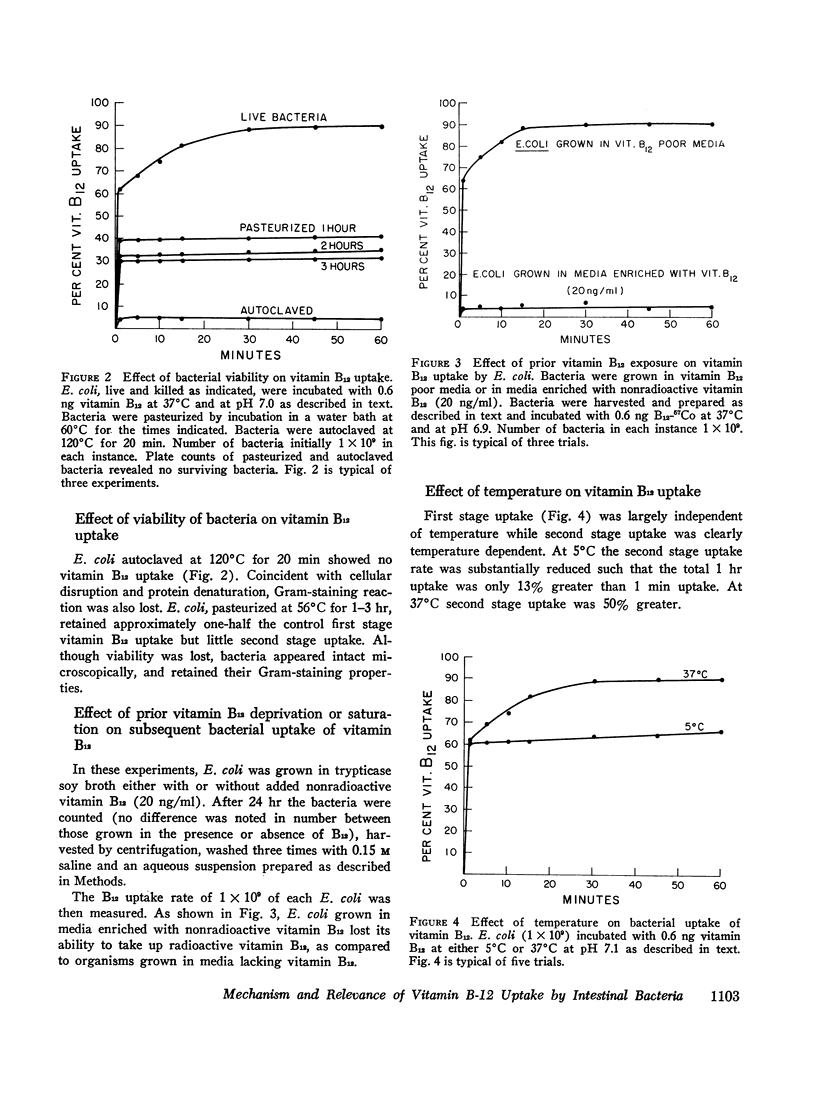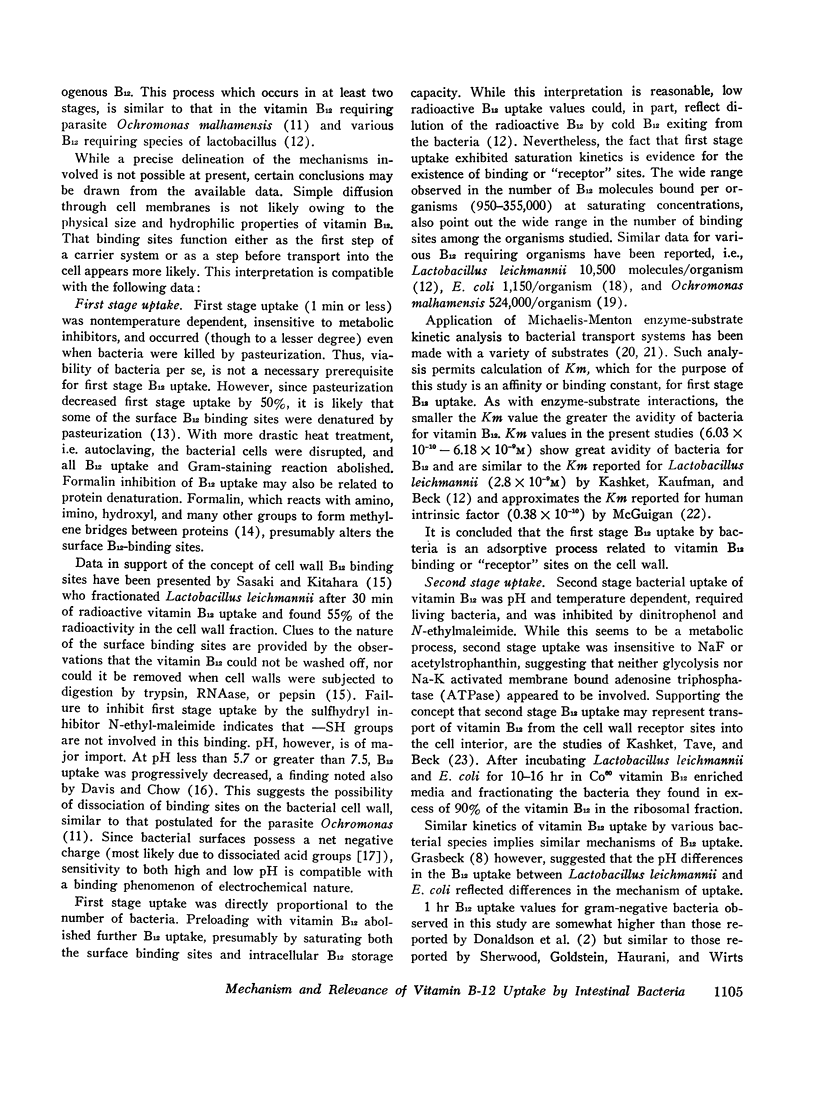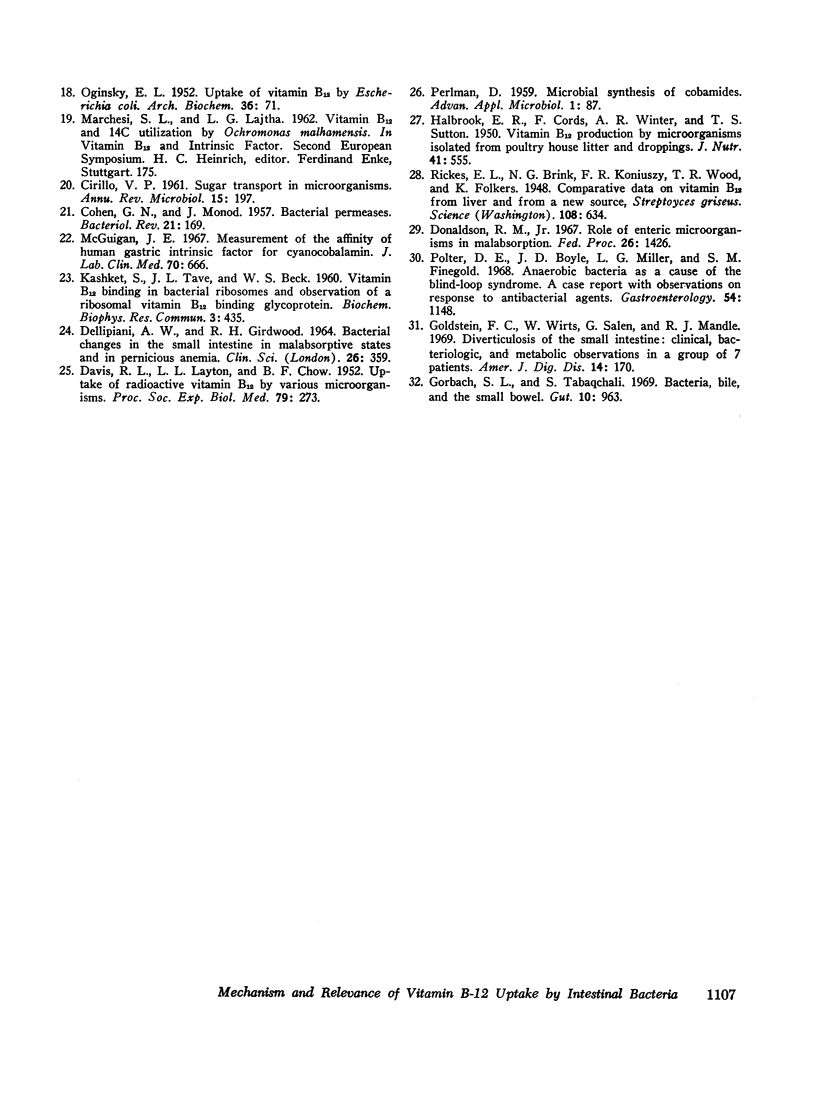Abstract
The mechanism of bacterial uptake of vitamin B12, the spectrum of microorganisms capable of such uptake, and the factors involved were the subject of this study. Bacterial uptake of vitamin B12 was found to be at least a two stage process. A primary uptake phase which was rapid (1 min or less), pH dependent, nontemperature dependent, did not require viable organisms and was insensitive to either the metabolic inhibitor dinitrophenol or to the sulfhydryl inhibitor N-ethyl-maleimide. Protein denaturation (formalin treatment or autoclaving) abolished all B12 uptake. This primary uptake phase is thought to represent adsorption to binding or “receptor” sites on the cell wall. Second stage uptake was slower, pH and temperature dependent, required living bacteria, and was abolished by either dinitrophenol or N-ethyl-maleimide. This phase is dependent upon metabolic processes and may reflect transfer of B12 from surface “receptor” sites into the bacterial cell. Although differences among organisms were observed in total 1 hr uptake, number of surface “receptor” sites, and relative avidities for B12, all organisms except Streptococcus fecalis shared the two stage mechanism. Two Gram-positive organisms. Bacillus subtilis and Group A streptococcus, demonstrated the highest 1 hr vitamin B12 uptake values; Gram-negative bacteria required 2,000-10,000 the number of organisms for comparable uptake. Binding constants (Km) varied from 5.05 ±1.67 × 10-10M for B. subtilis to 6.18 ±3.08 × 10-9M for Klebsiella pneumoniae which approximate the Km for human intrinsic factor (0.38 × 10-10M). Competition between bacteria and intrinsic factor for vitamin B12 may be inferred from the similarity of these constants.
These observations suggest that a variety of enteric and nonenteric organisms, not requiring exogenous B12, may play a role in the pathogenesis of the vitamin B12 malabsorption found in the intestinal bacterial overgrowth syndromes.
Full text
PDF







Selected References
These references are in PubMed. This may not be the complete list of references from this article.
- BOOTH C. C., HEATH J. The effect of E. coli on the absorption of vitamin B12. Gut. 1962 Mar;3:70–73. doi: 10.1136/gut.3.1.70. [DOI] [PMC free article] [PubMed] [Google Scholar]
- COHEN G. N., MONOD J. Bacterial permeases. Bacteriol Rev. 1957 Sep;21(3):169–194. doi: 10.1128/br.21.3.169-194.1957. [DOI] [PMC free article] [PubMed] [Google Scholar]
- DAVIS R. L., LAYTON L. L., CHOW B. F. Uptake of radioactive vitamin B12 by various microorganisms. Proc Soc Exp Biol Med. 1952 Feb;79(2):273–276. doi: 10.3181/00379727-79-19349. [DOI] [PubMed] [Google Scholar]
- DELLIPIANI A. W., GIRDWOOD R. H. BACTERIAL CHANGES IN THE SMALL INTESTINE IN MALABSORPTIVE STATES AND IN PERNICIOUS ANAEMIA. Clin Sci. 1964 Jun;26:359–374. [PubMed] [Google Scholar]
- DOIG A., GIRDWOOD R. H. The absorption of folic acid and labelled cyanocobalamin in intestinal malabsorption, with observations on the faecal excretion of fat and nitrogen and the absorption of glucose and xylose. Q J Med. 1960 Jul;29:333–374. [PubMed] [Google Scholar]
- DONALDSON R. M., Jr Malabsorption of Co60-labeled cyanocobalamin in rats with intestinal diverticula. I. Evaluation of possible mechanisms. Gastroenterology. 1962 Sep;43:271–281. [PubMed] [Google Scholar]
- Davis R. L., Chow B. F. Some Applications of the Rapid Uptake of Vitamin B12 by Resting Lactobacillus leichmannii Organisms. Science. 1952 Mar 28;115(2987):351–352. doi: 10.1126/science.115.2987.351. [DOI] [PubMed] [Google Scholar]
- Donaldson R. M., Jr Role of enteric microorganisms in malabsorption. Fed Proc. 1967 Sep;26(5):1426–1431. [PubMed] [Google Scholar]
- GRASBECK R. The vitamin B12-binding principle of human gastric juice: influence of pH on the bacterial adsorption of free and bound B12. Scand J Clin Lab Invest. 1957;9(1):50–53. doi: 10.3109/00365515709088113. [DOI] [PubMed] [Google Scholar]
- Goldstein F., Wirts C. W., Salen G., Mandle R. J. Diverticulosis of the small intestine. Clinical, bacteriologic, and metabolic observations in a group of seven patients. Am J Dig Dis. 1969 Mar;14(3):170–181. doi: 10.1007/BF02235878. [DOI] [PubMed] [Google Scholar]
- Gorbach S. L., Tabaqchali S. Bacteria, bile, and the small bowel. Gut. 1969 Dec;10(12):963–972. doi: 10.1136/gut.10.12.963. [DOI] [PMC free article] [PubMed] [Google Scholar]
- HALBROOK E. R., CORDS F., WINTER A. R., SUTTON T. S. Vitamin B12 production by microorganisms isolated from poultry house litter and droppings. J Nutr. 1950 Aug 10;41(4):555–563. doi: 10.1093/jn/41.4.555. [DOI] [PubMed] [Google Scholar]
- KASHKET S., TAVE J. L., BECK W. S. Vitamin B12 binding in bacterial ribosomes and observation of a ribosomal vitamin B12 binding glycoprotein. Biochem Biophys Res Commun. 1960 Oct;3:435–440. doi: 10.1016/0006-291x(60)90059-0. [DOI] [PubMed] [Google Scholar]
- MALLMANN W. L., BROITMAN S. A. A surface plating technic for determining bacterial population of milk. Am J Public Health Nations Health. 1956 Aug;46(8):1018–1020. doi: 10.2105/ajph.46.8.1018. [DOI] [PMC free article] [PubMed] [Google Scholar]
- McGuigan J. E. Measurement of the affinity of human gastric intrinsic factor for cyanocobalamin. J Lab Clin Med. 1967 Oct;70(4):666–672. [PubMed] [Google Scholar]
- OGINSKY E. L. Uptake of vitamin B12 by Escherichia coli. Arch Biochem Biophys. 1952 Mar;36(1):71–79. doi: 10.1016/0003-9861(52)90378-0. [DOI] [PubMed] [Google Scholar]
- PERLMAN D. Microbial synthesis of cobamides. Adv Appl Microbiol. 1959;1:87–122. doi: 10.1016/s0065-2164(08)70476-3. [DOI] [PubMed] [Google Scholar]
- Polter D. E., Boyle J. D., Miller L. G., Finegold S. M. Anaerobic bacteria as cause of the blind loop syndrome. A case report with observations on response to antibacterial agents. Gastroenterology. 1968 Jun;54(6):1148–1154. [PubMed] [Google Scholar]
- Reeves R. B., Fay F. S. Cyanocobalamin (vitamin B12) uptake by Ochromonas malhamensis. Am J Physiol. 1966 Jun;210(6):1273–1278. doi: 10.1152/ajplegacy.1966.210.6.1273. [DOI] [PubMed] [Google Scholar]
- Rickes E. L., Brink N. G., Koniuszy F. R., Wood T. R., Folkers K. Comparative Data on Vitamin B12 From Liver and From a New Source, Streptomyces griseus. Science. 1948 Dec 3;108(2814):634–635. doi: 10.1126/science.108.2814.634-a. [DOI] [PubMed] [Google Scholar]
- SASAKI T., KITAHARA K. A role of the cell wall as a "primary reservoir" of vitamin B12 in a B12-requiring Lactobacillus. Biochim Biophys Acta. 1963 Jul 2;74:170–172. doi: 10.1016/0006-3002(63)91354-4. [DOI] [PubMed] [Google Scholar]
- SHERWOOD W. C., GOLSTEIN F., HAURANI F. I., WIRTS C. W. STUDIES OF THE SMALL-INTESTINAL BACTERIAL FLORA AND OF INTESTINAL ABSORPTION IN PERNICIOUS ANEMIA. Am J Dig Dis. 1964 Jun;9:416–425. doi: 10.1007/BF02239334. [DOI] [PubMed] [Google Scholar]


